Overwhelmed at this point by opinions masquerading as fact; belief is a poor substitute for hard data. There have been far to many here offering verifiable science that is constantly swatted aside to try to engage in the dick measuring contest. I'm here to learn, not preach.Just dont contribute too much bro please you are overwhelming us with info and science
Fucking joke.
You are using an out of date browser. It may not display this or other websites correctly.
You should upgrade or use an alternative browser.
You should upgrade or use an alternative browser.
LED and BUD QUALITY
- Thread starter Tropical Sun
- Start date
So sit tight and keep your comments about me or any other person to yourself
You wanna discuss science and facts so stay on the topic !
If you don't know anything about lights, at least don't show it, silence is gold
Sorry to inform you, no one here is in the realm of faith when it comes to lights
Now, if you having a hard time accepting facts that has been known for many years, and u rather call them opinion, that's on you,
But I advise you to go fill in the blanks.
You wanna discuss science and facts so stay on the topic !
If you don't know anything about lights, at least don't show it, silence is gold
Sorry to inform you, no one here is in the realm of faith when it comes to lights
Now, if you having a hard time accepting facts that has been known for many years, and u rather call them opinion, that's on you,
But I advise you to go fill in the blanks.
[Maschinenhaus]
Active member
Please do not argue, we all assume and guess more than we actually know?
When making SMD lamps from LED for cannabis, I think two things are important.
Point 1)
The intensity must be right and not only in the range of the spectrum from 400nm to 700nm, I already noticed this with the High CRI five band fluorescent tubes compared to NDL during flowering. The advantages of High CRI LED SMD are faster maturity of the trichomes, but one hardly observes any discoloration after amber, so that even experts get difficulties when to harvest.
For LED a mixture of normal and High CRI SMD is recommended, also a mixture between COB and SMD, for CMH and Plasma it is not necessary.
Point 2)
The cyan gap should be closed and you have to calculate exactly how much deep red (DR) and near infrared (NIR) the installed SMDs provide and then match it with blue - green - yellow. During the day, the red spectrum does not predominate, but UV light, the blue and green to yellow range dominates, but red ranges have a different weight in photosynthesis, hemp reacts very strongly to it.
Bruce Bugbee is meanwhile criticized from the research, newest research comes to completely different realizations if one considers ranges before 400nm and after 700nm. Nevertheless, his work is still important for the basic understanding of photosynthesis in cannabis.
Much older research was done on algae and bacteria, flowers and lettuce!
When making SMD lamps from LED for cannabis, I think two things are important.
Point 1)
The intensity must be right and not only in the range of the spectrum from 400nm to 700nm, I already noticed this with the High CRI five band fluorescent tubes compared to NDL during flowering. The advantages of High CRI LED SMD are faster maturity of the trichomes, but one hardly observes any discoloration after amber, so that even experts get difficulties when to harvest.
For LED a mixture of normal and High CRI SMD is recommended, also a mixture between COB and SMD, for CMH and Plasma it is not necessary.
Point 2)
The cyan gap should be closed and you have to calculate exactly how much deep red (DR) and near infrared (NIR) the installed SMDs provide and then match it with blue - green - yellow. During the day, the red spectrum does not predominate, but UV light, the blue and green to yellow range dominates, but red ranges have a different weight in photosynthesis, hemp reacts very strongly to it.
Bruce Bugbee is meanwhile criticized from the research, newest research comes to completely different realizations if one considers ranges before 400nm and after 700nm. Nevertheless, his work is still important for the basic understanding of photosynthesis in cannabis.
Much older research was done on algae and bacteria, flowers and lettuce!
Compendium: Earth-Water-Light-Microorganisms-Ion-Exchange-Nutrients
Chapter 8 Indoor cannabis cultivation - Many problems? Many problems can be prevented in advance, good gardeners know it, less is more! Interactions between nutrients - causes of malnutrition. Causes of nutrient deficiencies are inharmonious nutrient ratios in the soil, in addition to...
www.icmag.com
Compendium: Earth-Water-Light-Microorganisms-Ion-Exchange-Nutrients
Chapter 8 Indoor cannabis cultivation - Many problems? Many problems can be prevented in advance, good gardeners know it, less is more! Interactions between nutrients - causes of malnutrition. Causes of nutrient deficiencies are inharmonious nutrient ratios in the soil, in addition to...
www.icmag.com
Factors affecting growth and flowering
Chapter 8 Indoor cannabis cultivation - Many problems? Many problems can be prevented in advance, good gardeners know it, less is more! Interactions between nutrients - causes of malnutrition. Causes of nutrient deficiencies are inharmonious nutrient ratios in the soil, in addition to...
www.icmag.com
Somewhat of a recurring pattern for me; my introductory post on a new thread puts the wrong foot forward alienating a potential source of knowledge and needlessly starts a war of words that no one really wins.
I've worked with CFL, HID, Blurple, COB, and full spectrun panels but haven't ever harvested by close up inspection of trichome development - only happy that I keep myself from spending any cash buying someone else's product.
My topping routine in action with a week's progress under an old school 90 w UFO - robust and healthy but node spacing leads me to fear this will ultimately evidence as male.
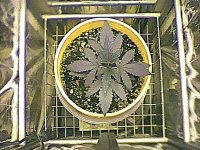
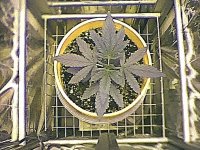
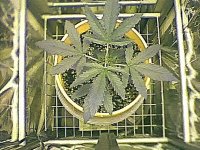

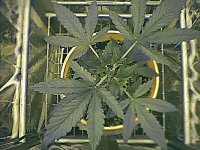
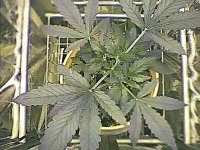

I've worked with CFL, HID, Blurple, COB, and full spectrun panels but haven't ever harvested by close up inspection of trichome development - only happy that I keep myself from spending any cash buying someone else's product.
My topping routine in action with a week's progress under an old school 90 w UFO - robust and healthy but node spacing leads me to fear this will ultimately evidence as male.






[Maschinenhaus]
Active member
About zoom-ins, this field of trichome study under certain intensity and spectrum is still grey area, im pointing it out to people and they laugh at me, but they cant hide the truth for long
If you zoom in enough you can make any trichome head make big and solid
im not saying yours dont get to the point they are not heads, because they are, but size?
The State University of Idaho is actively researching this, you really should pay attention to the scientists as well.
But that's pious wishful thinking on my part.
Temperature is key, and if there's one thing we've seen, it's that temperatures under LED are often too cool. In addition to the poor spectrum of LED lamps, the industry is throwing around terms that they probably don't understand themselves. Many know from their experiments with UV-B tubes, which reptiles like and need, quickly realize this is a dead end.
NUV starting at 380nm and that at an intensity that would be about up to 500nm the right way to call up genetic potential, but you would rather have certain terpenes stimulated with certain spectra, the main thing is that it smells somehow different, stronger?
The truth is that NUV and NIR, cyan etc., could be imaged correctly, it is just more complex and therefore more expensive. SANlight is going the right way with their Soul Semiconductor and Osram based lamps.
Conversely, outside in full sun in midsummer is not a nice life for plants either. I've seen the stress growers in California have had to provide adequate water to all their plants on a daily basis. The plants had stress even though they were gigantic, but the gigantic growth, the huge leaves are also a protective mechanism from the harsh sunlight and the harsh climatic conditions.
Yes, the terpenes that are quickly blown away by the wind under the harsh sun are the next "big thing" for the industry and the black market to condition a generation. Treated weed, if it only smells good enough and hits the stoner head good, can only be good, right? The Stupid Give Their Money....
Terpenes are always replicated, in fact you should avoid temperatures above 29 °C or 84.2 °F because some genetics tend to grow extremely long. A properly built LED doesn't have to be expensive either, the best lamps are often homemade.
If this has already been posted, I apologize.
Exploring the fascinating development of cannabinoid-producing trichomes by Amir Punja
Exploring the fascinating development of cannabinoid-producing trichomes by Amir Punja
I agree with u on the gap in LEDs spectrum, and I think this is a big part of their problem, as under more specific COBs the product is a bit better
Temp is not key when u work with poor lights, good temp won't make your product top notch all of a sudden.
I tested this concept in LEDs, you do see improvement with added heat, but not to the point it even matters, the product is now a lil better shit, but still shit.
Still, nothing can reach the intensity of HIDs
Those that claim that led are more intense just quote the efficiency of the tech itself as a standalone 1 w diode vs 1 w HID, which in real life doesn't exist.
All in all, I'm not rooting for one or the other, it's just important that people will understand the actual science and truth behind these concepts and tech.
Temp is not key when u work with poor lights, good temp won't make your product top notch all of a sudden.
I tested this concept in LEDs, you do see improvement with added heat, but not to the point it even matters, the product is now a lil better shit, but still shit.
Still, nothing can reach the intensity of HIDs
Those that claim that led are more intense just quote the efficiency of the tech itself as a standalone 1 w diode vs 1 w HID, which in real life doesn't exist.
All in all, I'm not rooting for one or the other, it's just important that people will understand the actual science and truth behind these concepts and tech.
[Maschinenhaus]
Active member
It is once this gap, then the often weak intensity in this area is added. COB LED such as the CLU048 -CRI80 in 4,000 Kelvin still has 32% in the intensity at 480nm.I agree with u on the gap in LEDs spectrum, and I think this is a big part of their problem, as under more specific COBs the product is a bit better
Here is the comparison and why I still use 4,000 Kelvin COB LED:
If then additional red like 660nm and 730nm is added then you have an extreme imbalance.
In the expensive profile lamps, for example, SunLike SMD from Seoul Semiconductor are installed with 6,500 Kelvin, they do not have this cyan gap and are like the Bridgelux Thrive SMD from 5,000 Kelvin well suited for the construction of circuit boards.
Here, and only here, we are talking about about full spectrum!
Seoul Semiconductor's SunLike will soon replace the CMH.
[Maschinenhaus]
Active member
All this time I thought that High CRI were superior to COB, it was other SMD from Bridgelux and Seoul Semiconductor that made good spectra for modern lamps from research.Check Cannary post about spectrum and nutes uptake, only adding to the problem of LEDs.
If you look at the comparison with good CMH, you will see the technical superiority and the LED offer much more advantages, with the same spectrum and the intensity within the spectrum. Dimming and multiple channels that can be programmed are a few of these advantages.
Otherwise I agree with you, CMH and Plasma remain a very good alternative and are superior to 08/15 solutions with LED like Samsung LM301B/H.
Samsung is of course catching up, the market is highly competitive and everyone is dancing around the golden calf in delight.
On paper yes, the advantages are there, in real life it's kinda of differentIf you look at the comparison with good CMH, you will see the technical superiority and the LED offer much more advantages, with the same spectrum and the intensity within the spectrum. Dimming and multiple channels that can be programmed are a few of these advantages.
Same spectrum is achievable, intensity within the spectrum is nice feature to have if you have the light source to back it up
Again, most of the led advantages are in the user interface friendly section, what about the plants ?
Led will never be intense like hid in real life, simply because HIDs come in higher watts per source and diodes dont.
It's not a fight who will make more outta 1 w of current, it's about which single source may it be the sun, hid, led in its current form that delivers the most intensity.
[Maschinenhaus]
Active member
On paper yes, the advantages are there, in real life it's kinda of different Same spectrum is achievable, intensity within the spectrum is nice feature to have if you have the light source to back it up Again, most of the led advantages are in the user interface friendly section, what about the plants ?
Do you have a scientific thesis that supports your statement?
Because I mean if the spectrum and the intensity are almost identical, but the LED bring more or the same performance, with less power consumption, where does that lead a HID, LEC or plasma then except perhaps the price?
But they are not, led don't bring same or more in real life. that's why I said in the current form, not futuristic one.
Spectrum wise led will be better in time then HIDs, even today if you diy you can get to good results spectrum wise.
You don't need science to tell you that when u put a light next to a light, you are not adding intensity, just qty of light in the space.
Read the whole thread, you cannot add intensity by dividing the source, only by adding voltage to the same source.
If I put 4 150w hps, I don't have a 600w hps machine, I have 4 150w, simple as that, I won't get 600w bulb readings under this system simply cuz you cannot go above the rated source of the 4 150 you started with
Same principal for LED diodes.
Spectrum wise led will be better in time then HIDs, even today if you diy you can get to good results spectrum wise.
You don't need science to tell you that when u put a light next to a light, you are not adding intensity, just qty of light in the space.
Read the whole thread, you cannot add intensity by dividing the source, only by adding voltage to the same source.
If I put 4 150w hps, I don't have a 600w hps machine, I have 4 150w, simple as that, I won't get 600w bulb readings under this system simply cuz you cannot go above the rated source of the 4 150 you started with
Same principal for LED diodes.
[Maschinenhaus]
Active member
The radiative intensity is meant, if I increase the CLU048 in the range of 480nm with additional special LEDs I achieve the desired spectrum.
With boards that I have assembled according to my specifications, I also achieve a higher efficiency of the entire system. The entire range in the near UV, violet, blue, green is raised and is higher than the range red, NIR.
So I achieve more than CMH at NUV and have per controller an increased red range up to 730nm, but I believe that the additional lifting of 660nm to 730nm will not be necessary?
The model was always the sun in summer.
With boards that I have assembled according to my specifications, I also achieve a higher efficiency of the entire system. The entire range in the near UV, violet, blue, green is raised and is higher than the range red, NIR.
So I achieve more than CMH at NUV and have per controller an increased red range up to 730nm, but I believe that the additional lifting of 660nm to 730nm will not be necessary?
The model was always the sun in summer.
Sounds good spectrum wise, you still lack the intensity...
You can't build a model that will be more intense then HIDs
Put 5000 diodes, won't work, remember our dividing the source law ?
Now let's have a look at reality, people have grown the dankest weed with poor spectrums for many years, not saying that full spectrum is not worth the research and invest, it is, but to what point ?
So u got the perfect spectrum, but you lack the intensity to back it up.
Like everything in life, balance is key, no one knows whats the balance in the spectrum/intensity range yet (in man made lights), we have clues, like high intensity and poor spectrum (LPS) will grow plants but not good, and we know that top notch spectrum but poor intensity (LEDs) will grow plants but also not good
HPS are borderline bulbs, CMH are better in balancing this equation, still not 100% but hey who is perfect ? Well...the sun, but not in the way you think, the sun just give 100/100 on both parameters, not 50/50
The intensity and spectrum (which means what power goes to making and delivering which wavelength) are very strong in all ranges.. sure some more then others but it don't mean they are less powerful.
Now we realize that even with balance, some stuff are more important in different aspects, years of growing amazing buds with CFLs, HPSs, prove this, intensity is more important then spectrum.
You can't build a model that will be more intense then HIDs
Put 5000 diodes, won't work, remember our dividing the source law ?
Now let's have a look at reality, people have grown the dankest weed with poor spectrums for many years, not saying that full spectrum is not worth the research and invest, it is, but to what point ?
So u got the perfect spectrum, but you lack the intensity to back it up.
Like everything in life, balance is key, no one knows whats the balance in the spectrum/intensity range yet (in man made lights), we have clues, like high intensity and poor spectrum (LPS) will grow plants but not good, and we know that top notch spectrum but poor intensity (LEDs) will grow plants but also not good
HPS are borderline bulbs, CMH are better in balancing this equation, still not 100% but hey who is perfect ? Well...the sun, but not in the way you think, the sun just give 100/100 on both parameters, not 50/50
The intensity and spectrum (which means what power goes to making and delivering which wavelength) are very strong in all ranges.. sure some more then others but it don't mean they are less powerful.
Now we realize that even with balance, some stuff are more important in different aspects, years of growing amazing buds with CFLs, HPSs, prove this, intensity is more important then spectrum.
[Maschinenhaus]
Active member
Well I want to start from January, when it is professionally quieter again, a grow on 1.44m² with 350 watts with LED, also to continue to learn with this lighting technology.
After that, in the fall of 2023 I will do a grow with "only" 315W CMH on 1.44m², same soil mix, same variety from a batch of seeds.
Maybe this will help us with the analysis?
After that, in the fall of 2023 I will do a grow with "only" 315W CMH on 1.44m², same soil mix, same variety from a batch of seeds.
Maybe this will help us with the analysis?
I don't know what analysis are you talking about... What is left ? The data and science behind each tech is very simple and straight forward, it's easy to understand which tech does what better.
Nonetheless, I will keep my eyes open on LEDs, they are progressing, when they get to a point that the dry data is factual and not witch craft maths and equations I will give them another go for flowering.
Nonetheless, I will keep my eyes open on LEDs, they are progressing, when they get to a point that the dry data is factual and not witch craft maths and equations I will give them another go for flowering.


